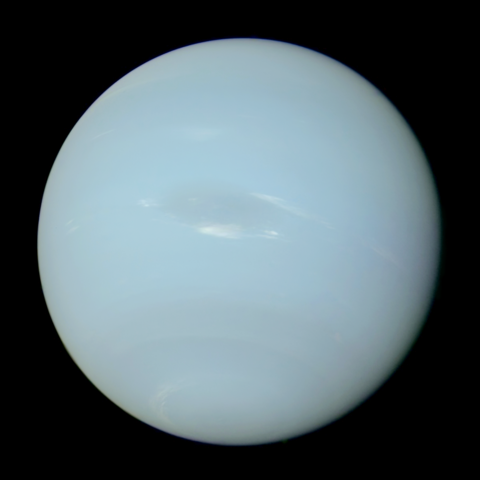
Is there a planet beyond Neptune? It is possible, but there is no way to know for sure until telescope power increases.
Neptune was discovered in 1846 and it was the last planet to be discovered. Pluto was discovered in 1930, but it wasn’t a planet for very long before it was demoted to “dwarf planet”. It isn’t possible to see Neptune with the naked eye because it is too far away and there was no knowledge of it. It can be seen with a telescope, but it is so far away and its orbit is so large that finding it by chance was very unlikely. It orbits at about 4.5 billion km away from the sun and takes 164 years to make one orbit. The chance of looking in the right part of the sky with a telescope and finding it was remote. In the end, Neptune was found because of math. Uranus had been discovered in 1781, and astronomers noticed that its orbit was not perfect. They realized that its orbit was being affected by a larger planet that lay beyond it. In 1845, two astronomers calculated the effect on the orbit and predicted where the new planet would be. On September 23rd, 1846, Neptune was discovered, almost exactly where they said it would be.
Once Neptune was found, astronomers noticed anomalies in its orbit as well and figured that there was another, even larger planet beyond it. In 1930, Pluto was discovered and people thought that was the reason for the anomaly with Neptune. However, Pluto is far too small to have that much of an effect on Neptune and it was written off. When the discovery that Pluto was too small was made, many astronomers thought that there must be another, even larger planet out beyond Neptune. Here are the reasons why that might be possible.
One reason is that there are a lot of small objects that orbit the sun out beyond the range of Neptune. Pluto is one of these, but there are over 2,000 more. These objects appear to be affected by the gravity of something that is not Neptune. In theory, Neptune is the largest object in the vicinity of these objects, so it should have the biggest effect on their orbit, but it doesn’t seem to and most of them are detached from Neptune’s orbit. A lot of them also have very unusual orbits in that they come from very far out in the solar system, go closer to the sun, and then go very far out in the solar system again. An explanation for some of these objects being locked on to Neptune’s orbit and some not, could be a giant planet far out at the edge of the solar system.
Another reason is a large gap in the middle of the Kuiper Belt. The Kuiper Belt is a disc of planetoids and small bodies, such as rock and ice. It is a ring that is about 50 AU from the sun. (1 AU is the distance from the sun to Earth). Pluto is one of the planetoids in the Kuiper Belt. There appears to be a gap in the belt, called the Kuiper cliff. There are hundreds of thousands of bodies in the belt, and suddenly, just after this cliff, they disappear. It could be that the material at that distance is too scarce to clump together into larger bodies, or it could be because all of the material has been cleaned up to make a 9th planet that is orbiting round in the Kuiper Belt. This gap is about 72 AU, so if there is a planet that has been made from all of this material, it must be large.
A third reason is the sheer size of the solar system. It stretches for over 100,000 AU, culminating in the Oort cloud. The sun’s gravity extends that far and if there is enough material for things like the Kuiper Belt and the Oort cloud, it is not impossible that a large planet accrued out of this material. If it is there, it could be so far out that we could only find it by pure luck or when we have telescopes powerful enough to see that well.
When Voyager 2 flew past Neptune, astronomers worked out that Neptune wasn’t as big as they had calculated. When they factored that into their models, they discovered that the orbit of Neptune didn’t have any anomalies, which made it unlikely that there was another planet out there. Also, the WISE telescope has scanned the solar system as far out as 26,000 AU and there are no planets as large as Saturn or Jupiter. However, that doesn’t mean there isn’t a planet larger than Earth but smaller than Saturn. The last piece of evidence that there might be this planet is the orbit of an asteroid called BP519. It was discovered in 2015 and it has an orbit around the sun that brings it to 35 AU at its closest and 863 AU at its furthest. Not only that, it is tilted by 54 degrees to the rest of the solar system. Because everything in the solar system was made from the same material, it should all be orbiting in the same way, unless there is a reason for it to be different. Astronomers don’t know the reason why BP519 orbits like this, but if they add a large planet that is 10 times bigger than Earth into their models, the orbit suddenly makes sense. I wonder when we will find out. And this is what I learned today.
Image By NASA / Voyager 2 / PDS / OPUS / Ardenau4 – Own workalso published on Flickr: https://www.flickr.com/photos/197038812@N04/53446862462/, CC0, https://commons.wikimedia.org/w/index.php?curid=143615671
Sources
https://science.nasa.gov/solar-system/oort-cloud/facts
https://science.nasa.gov/solar-system/oort-cloud/facts
https://en.wikipedia.org/wiki/Trans-Neptunian_object
https://www.space.com/planet-nine-explain-odd-icy-body-behavior-beyond-neptune
https://www.earth.com/news/massive-earth-like-planet-may-be-hiding-just-beyond-neptune
